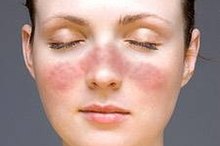Causes of a Skin Rash on Hands and Feet
According to the University of Maryland Medical Center, a rash is defined as any change in the texture or color of the skin 2. A skin rash on the hands and feet may be caused by an external irritant such as poison ivy or may be the symptom of an illness. Treatment for rashes on the hands and feet is typically dependent on the underlying cause or condition. If a rash does not improve or gets worse, the patient should contact a health-care provider immediately.
Psoriasis
Psoriasis is a condition caused by a disruption in the life cycle of skin cells. With psoriasis, both new and dead skin cells gather in the outermost later of skin too quickly, causing thick, scaly patches on the surface of the skin. This condition often leads to symptoms in the form of a rash and can affect most parts of the body, including the neck, back, hands and feet. Symptoms of psoriasis include dead or cracked skin that may bleed when aggravated or peeled and joints that become swollen or stiff. Treatments for psoriasis includes topical creams--corticosteroids and retinoids--light therapy and a variety of oral medications.
- Psoriasis is a condition caused by a disruption in the life cycle of skin cells.
- With psoriasis, both new and dead skin cells gather in the outermost later of skin too quickly, causing thick, scaly patches on the surface of the skin.
Dermatitis
Diseases Causing Skin Rash
Learn More
Dermatitis can cause a rash on any part of the body, including the hands and feet. Although dermatitis does not lead to complications, the condition can be extremely uncomfortable. There are several types of dermatitis: seborrheic dermatitis, affecting the scalp; allergic dermatitis; and eczema. Allergic or contact dermatitis is a rash due to the skin coming into contact with a specific external irritant such as poison ivy, soaps and detergents. Symptoms include red skin, itchiness and burning. Treatment for dermatitis usually requires some form of topical medication, such as hydrocortisone creams, to reduce symptoms. Patients should avoid any material that may cause an allergic reaction to occur.
- Dermatitis can cause a rash on any part of the body, including the hands and feet.
- Treatment for dermatitis usually requires some form of topical medication, such as hydrocortisone creams, to reduce symptoms.
Hand-Foot-Mouth Disease
Hand-foot-mouth disease is a condition that involves rashes on the hands, feet and mouth 1. It generally occurs in children and is caused by a coxsackievirus. Hand-foot-mouth disease is contagious and is spread from person to person through contact with saliva, fluids from blisters, nose discharges or feces 1. The virus can also be spread through someone sneezing or coughing. Symptoms of hand-foot-mouth disease include rashes on the soles of the feet and palms of the hands and sometimes on the buttocks 1. The condition usually clears up on its own; oral medication may be applied to reduce signs of mouth sores. Although children typically grow immune to the disease at an early age, it is still possible for adolescents and adults to contract the disease.
Related Articles
References
- Mayoclinic.com: Hand-Foot-Mouth Disease
- University of Maryland Medical Center: Dermatitis
- Mayoclinic.com: Psoriasis
- American Academy of Dermatology Association. Contact Dermatitis: Signs and Symptoms.
- Aquino M, Rosner G. Systemic Contact Dermatitis. Clinical Reviews in Allergy and Immunology. 2019 Feb;56(1):9-18. doi:10.1007/s12016-018-8686-z
- Mowad CM, Anderson B, Scheinman P, Pootongkam S, Nedorost S, Brod B. Allergic Contact Dermatitis: Patient Management and Education. Journal of the American Academy of Dermatolgy. 2016 Jun;74(6):1043-54. doi:10.1016/j.jaad.2015.02.1144
- Pelletier JL, Perez C, Jacob SE. Contact Dermatitis in Pediatrics. Pediatric Annals. 2016 Aug 1;45(8):e287-92. doi:10.3928/19382359-20160720-06
- Rashid RS, Shim TN. Contact Dermatitis. BMJ. 2016 Jun 30;353:i3299. doi:10.1136/bmj.i3299
Writer Bio
Antonius Ortega is a 13-year veteran of the fitness industry and an athletic trainer certified by the American Council on Exercise. His articles on fitness, health and travel have appeared in newspapers such as the "The Hornet," "The Daily Bruin," and "Stars and Stripes." Ortega trains in Orange County.









